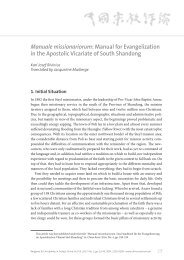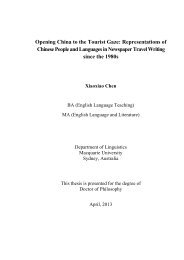EDUCATION IN CHINA
Education-in-China-a-snapshot
Education-in-China-a-snapshot
Create successful ePaper yourself
Turn your PDF publications into a flip-book with our unique Google optimized e-Paper software.
Chapter 1 – Organisation and management of education in China<br />
distributed is delineated in several official documents.<br />
However, within the approved amount of performance<br />
salary, each school can allocate independently.<br />
The performance salary of compulsory education is<br />
composed of a basic part and a bonus part. The basic<br />
part of performance salary makes up about 70% of the<br />
total amount of performance salary, and is determined<br />
by factors like regional economic development level, local<br />
price level and job responsibilities. The specific standard<br />
of allocation is determined by the personnel department,<br />
finance department and education department of local<br />
government at the county level and above. The basic<br />
share of performance salary is paid monthly, for the<br />
most part. The bonus component of performance salary<br />
amounts to 30% of the total, and is mainly related to<br />
workload and actual contribution. Allocation of the<br />
bonus part is based on appraisal, and determined by<br />
schools themselves. Based on the actual situation in<br />
schools, items like allowances for class teachers, subsidies<br />
for teachers in rural schools, allowance for extra class<br />
hours and bonuses for outstanding achievements are<br />
components of the performance salary.<br />
As for the allowance component, it mainly stands<br />
for allowances for teachers working in remote and<br />
underdeveloped areas, as well as allowances for special<br />
positions. The standard for allowances is developed by<br />
the central government and is uniform nationwide. The<br />
allowance for special positions of teachers in primary and<br />
secondary schools is composed of seniority allowance,<br />
senior teacher allowance, special education allowance<br />
and school reform allowance.<br />
Student affairs<br />
ADMISSIONS<br />
The Compulsory Education Law stipulates that nineyear<br />
compulsory education should be basically universal<br />
in all urban and rural areas of all provinces and for all<br />
ethnic minorities. However, providing and legislating<br />
compulsory education does not necessarily lead to the<br />
immediate eradication of education inequalities. Because<br />
of key school policies where selected “good” schools are<br />
given privileged resources, as well as the long-term lack<br />
of educational investment in rural areas, educational<br />
resources are unevenly distributed. In order to guarantee<br />
equal opportunity, the neighbourhood attendance policy<br />
dictates that students enrol in schools in their districts.<br />
But many families get around this policy by purchasing<br />
apartments near good schools or by using other means. At<br />
the same time, China’s economic development has caused<br />
massive migration, which has created new problems for<br />
the neighbourhood attendance policy. When families<br />
migrate, migrant children must change schools. The<br />
neighbourhood attendance policy can make it difficult<br />
for migrant children to enter schools in new districts. In<br />
response to this issue, local governments have adopted<br />
a series of measures according to the Compulsory<br />
Education Law to make sure that every child can have<br />
access to compulsory education. For example, following<br />
the 2003 Notice of Improving Education of Children of<br />
Rural Migrant Workers, local governments prohibited state<br />
schools from charging additional fees for migrant students.<br />
Recently, more policies have been issued to implement the<br />
neighbourhood attendance policy more thoroughly. Such<br />
policies have forbidden entrance exams for compulsory<br />
education and outlawed fees for school choice. Lawmakers<br />
have also developed open enrolment processes in order<br />
to guarantee a fair admissions system. At the same time,<br />
more specific strategies have been developed to ensure<br />
high-quality and balanced development of compulsory<br />
education throughout the country.<br />
STUDENT ENROLMENT AND THE STATUS<br />
<strong>IN</strong>FORMATION MANAGEMENT SYSTEM<br />
In 2010, the Ministry of Education began to build a<br />
national standardised student enrolment and status<br />
information management system. The system assigns<br />
to all students an enrolment number linked with his<br />
or her identification number (ID). Information about a<br />
student’s whole education process is recorded in the<br />
information system with this ID. By preventing counterfeit<br />
enrolment information from entering the system, and<br />
by curbing repeated registration in different provinces,<br />
this information system also helps officials make policy<br />
decisions, as well as monitor and administer the education<br />
system. For instance, through this system the Ministry of<br />
Education can easily obtain precise student statistics<br />
for one district, and even one specific school. This helps<br />
the Ministry make budget appropriations decisions and<br />
monitor educational spending. The information system is<br />
also available on line, which provides a great convenience<br />
to parents applying for school transfer. Officials use the<br />
system to help promote fair and open management of<br />
education in China.<br />
22 – <strong>EDUCATION</strong> <strong>IN</strong> CH<strong>IN</strong>A: A SNAPSHOT © OECD 2016





